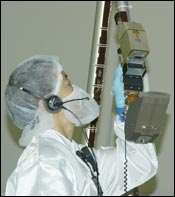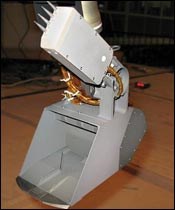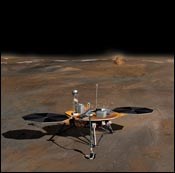A Finish that’s Out of this World
Hard anodized component is key to search for life on Mars
Perched atop a Delta II rocket, the National A eronautics and Space Administration’s Phoenix spacecraft blasted off from Cape Canaveral Air Force Base, FL in the predawn hours of August 4, 2007. Its destination: Mars.
After a journey of nearly nine months covering 422 million miles, on May 25 the spacecraft plunged into the Red Planet’s thin atmosphere at 12,750 mph before friction and a parachute slowed it to about 125 mph at an altitude of 0.6 mi. At that point, the lander separated from its parachute and a protective shell and began sequential firing of 12 rocket thrusters that slowed it to a landing speed of 5.5 mph.
Featured Content
If all that sounds complicated, consider that once it touched down on the polar region of Mars the craft’s real mission was just beginning. NASA outlined two broad objectives for the Phoenix program: to add to the growing body of knowledge of the history of water on Mars, and to determine if the Martian arctic soil could support life.
According to NASA, the craft’s payload of scientific instruments is ideally suited to uncover clues to the geologic history and biological potential of the Martian arctic. Phoenix is the first mission to return data from either polar region of Mars and will further the four science goals of NASA’s long-term Mars Exploration Program:
- Determine whether life ever arose on Mars
- Characterize the climate of Mars
- Characterize the geology of Mars
- Prepare for human exploration.
To accomplish those goals, Phoenix first unfurled two solar panels covering nearly 12 ft. The lander itself is 4 ft across and loaded with science equipment. Other instruments deployed right after touch-down included a camera system and weather tracking gear.
Enter ISAD
Another critical piece of equipment deployed not long after landing was Phoenix’s Icy Soil Acquisition Device (ISAD), which plays a critical role in the mission by serving as the primary means of acquiring soil samples for the craft’s analyses.
The device is both a soil scoop and a precision ice-sampling tool integrated on the end of an 8-ft robotic arm, and it features three tools for obtaining soil samples. It can scoop material like a backhoe using a front titanium blade, scrape the surface with a tungsten carbide secondary blade on the bottom of the scoop or use a high-speed rasp mounted in a slot at the back of the device.
The scoop was initially used to dig into the Martian surface surrounding the lander and acquire soil samples for delivery to science instruments for examination. The robotic arm dug a trench deep enough to access layers of ice-bearing soil, which was obtained using the high-speed rasp.
ISAD then transferred the icy soil to multiple onboard instruments, including a Thermal and Evolved Gas Analyzer (TEGA) instrument and wet chemical analysis. Phoenix’s wet chemistry laboratory is designed to test soil for salts, acidity and other characteristics, much like garden soils are tested on Earth, according to NASA.
The agency confirmed in June that a white substance in the soil samples obtained by Phoenix was indeed ice. Instruments have detected a variety of elements in the soil, including sodium, potassium and magnesium, but no organic materials so far, according to NASA. As this is written, mission controllers are trying different methods to get an icy sample into the robotic arm scoop—a process scientists compare to scraping a sidewalk. The agency has also extended funding for the mission, which was scheduled to run for three months, until the end of September.
Building ISAD
The ISAD was designed and manufactured by Honeybee Robotics (New York, NY), a company that specializes in development of automated mechanisms for industrial, defense, and aerospace applications. Honeybee designed, built and tested the unit in only 14 months after the Mars Phoenix mission’s science payload team determined that they needed an improved method of gathering samples from the strongest icy soil targets anticipated at the landing site.
When it came to finishing the business end of the device—the actual scoop that would dig into frozen Martian soil—Honeybee engineers specified a very complicated design incorporating multiple finishes for various surfaces of the scoop. Fortunately, they called on Anoplate Corp. (Syracuse, NY) to quote the finishing job.
“I’m not sure how the engineers at Honeybee heard about us—we certainly had not heard of them,” recalls Anoplate chief technology officer Milt Stevenson Jr. “They came to us with a very complicated design for the scoop that incorporated four or five different finishes. We talked with them about what they were trying to do, and we wound up hard anodizing 80% of the part and masking the other 20%.”
The complex finish engineers originally wanted was specified to meet rigid requirements for abrasion resistance and other criteria. “For example, there were outgassing criteria that had to be met, and they wanted no organics on the inside surface of the scoop because they didn’t want to contaminate the samples,” Stevenson says.
Machined from a solid billet of 7075 aluminum alloy, the scoop had multiple features that required masking. “There were some holes, for example, that were just too critical size-wise to accommodate the buildup of the hardcoat,” Stevenson says.
Over the last half of 2006, Anoplate and Honeybee worked through several iterations of the scoop design, then Anoplate ran some sample scoops that were subjected to various tests, including abrasion resistance in simulated Martian soil. “There were also outgassing checks,” Stevenson recalls. “They actually baked the anodized part in a chamber to be sure there were no organics present that could interfere with the soil analyses.”
Anoplate eventually anodized a total of six scoops, with the unit that’s now on Mars run at the end of 2006.
“The finish itself was conventional hard anodize,” Stevenson says. “The different things about the scoop job were the masking and the post-anodize cleaning that was needed to pass the contaminant tests. Cleaning involved ultrasonics, extended rinsing times, and final DI sealing to reach a level of cleanliness similar to that required in the semiconductor industry.”
Multiple Capabilities
According to Stevenson, finishing the ISAD scoop was a bit out of the norm for Anoplate—but not too far out.
“This kind of job is becoming more commonplace for us,” he says, “although more typical would be anodizing of thermal imaging devices that will be mounted on military vehicles to detect the presence of buried improvised explosive devices (IEDs). This was a new technology, and as you can imagine the military wanted to ramp it up very fast. The contractor was in a bind because they simply weren’t able to get the parts finished fast enough in the right color. There was a color-matching requirement.
“We took a lot of labor out of that part by designing fixtures that could be reused, and we didn’t use any consumable masking. That approach let us do the work quickly and repeatably.”
Working out of a 100,000 sq ft shop with more than 200 employees, Anoplate is equipped to handle jobs that some other shops can’t or won’t quote, according to Stevenson. “We offer a very broad range of coating processes—copper, nickel, chrome, zinc, all types of anodize, dry film lubricant and more,” he says. “About 25% of our business is related to electroless nickel, 25% to light metal finishing, and the other half is everything else.”
All finishing lines in the shop are manually operated. “The only automation we use is a robotic masking system that lays down stop-off material for high-volume jobs,” Stevenson says. “The reason is, a lot of our work involves multiple finishes on the same part—for example, anodize on 80% of a part and then three or four tabs that need to be tin-plated for solderability.
“That’s the kind of thing we thrive on, and every part is different,” he continues. “For a part like the one I just described, we might tin-plate the whole thing, mask the tabs and then strip off the tin before anodizing.”
Anoplate operates three shifts a day, five days a week, using Saturdays to work down any backlogs. According to Stevenson, the company’s key metric these days is turnaround time. “Everyone’s got the quality game down pretty well, so you need to figure out how you’re going to differentiate your shop,” he says. “One of the keys for us is how quickly we cycle jobs through the plant. Our goal is to have 75% of jobs out in three days, and we’re working to get there mainly by trying to streamline things on the front end.”
Leaning out quoting and process planning is especially important given the nature of Anoplate’s business, Stevenson says. “Probably a third of the jobs in the shop at any given time are brand new; we’ve never seen them before,” he explains. “So someone has to look at them, decide what needs to be done and decide how long each step is going to take.
“Traditionally, a job would come in to shipping, then go to a planner who would outline the processing sequence. Then it would go to another group to get estimated processing times. That group would turn it over to production planning, and then it would wind up back with the original group to actually print the shop traveler. The process was just too cumbersome to get anything out quickly. What we’re doing now is training the estimators to do the pricing and planning,” he concludes.
Once in the plant, jobs move with a more detailed traveler that enables a wider group of people to work on them. “In the old days, certain operators would always run certain jobs,” Stevenson says. “There was no cross-training. Now, there’s a lot more up-front training of personnel, and we’ve also made our documentation more user-friendly. That’s important because we’re no longer relying on 15 or 20 platers. We’ve got more than 140 platers.”
The company has ramped up its capabilities by converting some of its most talented platers into trainers. “Those people now take new platers under their wing for a period of 30–60 days and actually ramp up the training process,” Stevenson explains. “So, new employees are learning in a month or two what they might normally learn in a year.”
Yet another recent addition is an R&D lab that enables Anoplate to develop processes in a controlled environment rather than interrupting production on the floor or waiting for production to open up. “The lab has enabled us to take concepts to production in a matter of days rather than weeks or months,” Stevenson says.
RELATED CONTENT
-
Plating Q&A: Can you color stainless steel?
Our expert, Art Kushner, says yes, you can color stainless steel, but it is not a process that is typically performed in a plating shop. Read more about his answer.
-
Overview: Aerospace Anodize Finishes
The following anodizing process overviews are provided as a means of introduction to aerospace anodizing
-
Smut and Desmutting
Question: I am new to this industry and have heard about smut and desmutting operations.






















